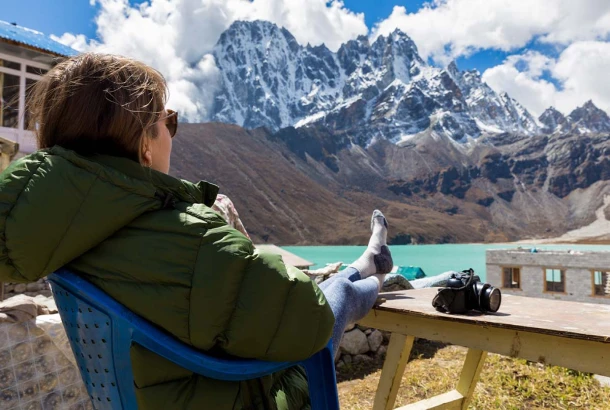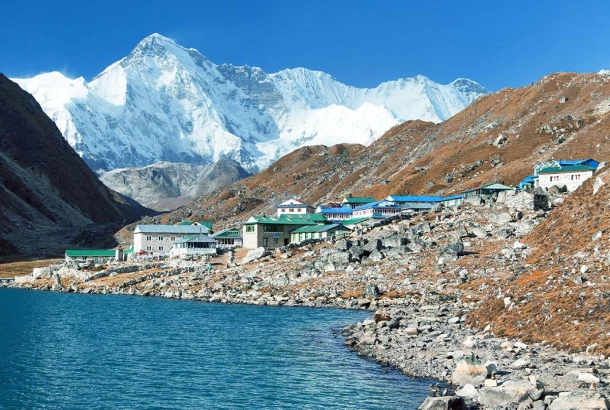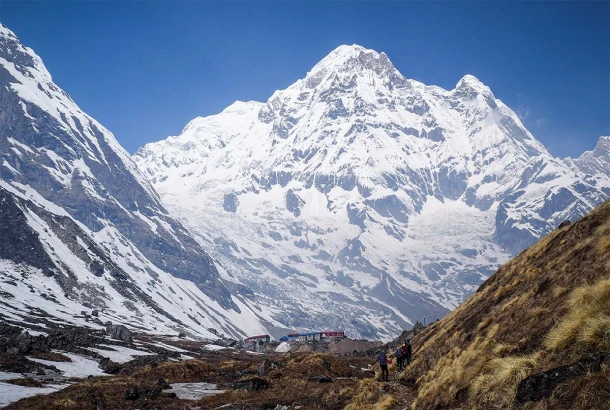Kanchenjunga Base Camp Trek Difficulty Level
The Kanchenjunga Base Camp Trek is among Nepal's most demanding trails both physically and psychologically. It is a 200km to 220km trek that generally lasts 17 to 25 days. Depending on the itinerary and how long you'll need to acclimatize. You'll experience hard and long days, usually walking 6 to 8 hours along challenging trails. Steep ascents, rocky paths, and slippery trails are all part of the adventure.
The trek is at high altitudes, and the North Base Camp is 5,143 meters and the South Base Camp is 4,610 meters. It leaves the body more exposed to altitude related issues, so adapting to the high altitude is very important.
When you compare it to other more popular trails, the Kanchenjunga region is remote and underdeveloped. With few facilities and no easy access to medical care. The remoteness demands independence on the part of trekkers, prepared for unpredictable weather, landslides, and challenging river crossings. The trail's remoteness and the requirement of special permits add to the logistical issues.
Although prior experience of high-altitude trekking is recommended, the Kanchenjunga Base Camp Trek is a challenging but rewarding expedition. It suits those adventurers who want to enjoy a true test of will and endurance.
What Makes the Kanchenjunga Base Camp Trek Physically Difficult?
The Kanchenjunga Base Camp Trek is one of Nepal's most challenging physical treks. It stretches up to 220 kilometers and is nearly three weeks long, during which time trekkers must walk through remote Himalayan terrain. Trekkers walk at least 6 to 9 hours a day, and 15 to 20 kilometers, which are tests of endurance and stamina.
Altitude plays a significant role in the challenge. The trek reaches heights of more than 5,100 meters. The oxygen is limited where there is a great danger of altitude sickness. Proper acclimatization is required as the body must adjust to the thin air to make the trek a success.
The landscape has steep climbs that are varied and rugged with precipitous drops, rocky trails, slippery patches and high-altitude passes. Certain sections involve crossing glacial rivers and walking through landslide areas. It is particularly after rain or during the monsoon season. As isolation of the area also translates into fewer teahouses and basic amenities. Being self-sufficient is a very important aspect for trekkers.
The weather is yet another challenge. The temperature shifts from hot to humid at low altitudes, then shifts from ice-cold to snowy at higher altitudes. All these combined make the Kanchenjunga Base Camp Trek a genuine test of physical stamina, perseverance, and durability.

How High Will You Go at the Kanchenjunga Base Camp Trek?
The Kanchenjunga Base Camp Trek offers a true high-altitude experience deep in the eastern Himalayas. You’ll reach the highest point at Pang Pema, which is known as the North Base Camp. It is located at 5,143 meters / 16,873 feet above sea level. This is considerably higher than many high-profile Himalaya base camps, so acclimatizing the body as much as the mind to levels of altitude is recommended.
Along the way, you will also be reaching the South Base Camp at a level of about 4,780 meters. The trek is a lot lower, and that gives your body time to acclimatize because you are trekking through forests, peaceful villages, and broad alpine meadows. Itineraries often incorporate acclimatization days so your body has time to acclimatize slowly at elevation and not experience the altitude sickness symptoms.
As you hit 5,000 meters, the air is thinner and each step more demanding. However, the views are well worth the struggle. You are treated to stunning views of Kanchenjunga, the world's third-highest peak, amidst peaks that are capped in white. While the altitude makes the trek an uphill task, trekking at a slow pace, careful planning, and attention to the ground can make this arduous journey an enjoyable outing with experiences to remember.
What are the Terrain Challenges at KBC?
The Kanchenjunga Base Camp trek is one of the remotest and wildest in Nepal. You begin your trek from the green hilly areas of Taplejung. From there, you walk through rainforest, across terraced fields, and over small streams. The road is tougher and steeper as you're higher up in altitude. All of it tests your stamina to its full extent in its long ascents and steep declines that test your balance.
Before you lie on rugged and uneven paths, most challenging during the monsoon when they are slippery. There are a couple of landslide points that one must always be aware of. At some points, you have to cross over high mountain ridges, slim ridges, and rock moraines. In the upper areas, the snow and ice usually fill the pathways, which adds to the difficulty levels of trekking. You’ll also need to cross rivers frequently, often using log bridges or hopping over stones, so steady footing is important.
Unlike other popular trekking routes, this region does not have as many teahouses and facilities. So, you hike for hours without any villages in sight and have to rely on your crew and sound planning. Because of its tough trails, mixed landscape, and remote location, the trek is an actual adventure. It's tough, but the rewards are all the work is worth.
Weather and Seasonal Conditions for the Kanchenjunga Base Camp Trek
The Kanchenjunga Base Camp Trek crosses varied landscapes from warm valleys to cold alpine. Therefore, the weather is changing quickly on the trail. The best season to visit is during spring (March to May) and autumn (September to November). In these seasons, you can be sure to enjoy clear skies and stable weather. The temperatures usually range from 10°C to 20°C dominate lower altitudes, and higher altitudes are usually below freezing. In spring, there are vibrantly colored rhododendrons in bloom along the entire hillside. Autumn sees dry trails and the most breathtaking mountain scenery.
During the monsoon (June to August), the path is slippery and wet. Frequent rain and leeches in lower areas make trekking risky at this time. Landslides and low visibility make it risky to trek here. Although the forests get lush and green, the terrain is not trekkable for most trekkers.
In winter (December to February), the region sees cold weather. The night temperature goes below -15°C, especially above 3,000 meters. Snow and ice can even shut down the trails, and wind is another limiting factor. Only serious and experienced trekkers would feel at ease during this time. Whatever time of the year you go, mountain weather changes fast. Hence, it is wise to prepare for anything and keep yourself updated.

Walking Duration and Daily Hours on the Trails
In the Kanchenjunga Base Camp Trek, you will usually walk for 5 to 8 hours daily. The time may be shorter depending on the part of the trail and terrain. Most mornings begin early. The trekkers wake up at 6:00 AM, have a hot breakfast and start the trails at 7:00 AM. Some are easy treks of 3 to 4 hours when it is an acclimatization day. But when crossing over the high passes or visiting base camps, you may walk 7 or 8 hours.
Since the trail changes, so does the experience of walking. You walk in dense forests, deep valleys, steep hills, rocky moraines and peaceful alpine meadows. Around midday, you usually rest for lunch at a teahouse or a scenic resting place. Then the walk continues for another couple of hours until you reach the next village or camp late in the afternoon.
Most importantly, the trek breaks up into rest and acclimatization days. These breaks allow your body time to acclimate to altitude and minimize the chance of altitude sickness. Though the day walks are demanding, you can pace yourself well with early starts, steady paces, and regular rests. It's tough, but one repaid a thousand times for every step you take.
How Remoteness Adds to the Challenge?
The Kanchenjunga Base Camp Trek takes you away from crowded towns and tourist treks. Solitude of this kind provides you with a better idea of nature, but brings in real hardship. As soon as you start the journey further into remote valleys and mountain trails, basic facilities begin to fade. You should not expect shops or well-stocked teahouses in most places. You therefore have to carry minimum supplies and accept plain food and accommodations.
When injured or ill, aid may take an extremely long time. Medical posts are minimal, and evacuation is slow. There is also a problem with communication. You can be out of cell phone range for days, thus it will be harder to call family or receive assistance. Due to this, trekkers will be asked to be very careful and have more dependence on the guide and the group.
The trail itself may be rocky and vague. There are no noticeable signposts or crowds like what you'll see on famous treks. You traverse isolated forests, narrow ridges, and steep passes with sudden climbs. Walking demands concentration and technique, especially in bad weather. But this same isolation provides serenity and meaning to your existence. You are able to view unspoiled landscapes and appreciate the peaceful pace of rural life. Although loneliness is hard, it also makes a lasting impression on those in search of adventure.
Prepare Your Body Through Fitness and Training
Enjoy the journey as you successfully undertake the Kanchenjunga Base Camp Trek. Your body must be conditioned in advance to go through the training and fitness process. This is a challenging trek where you need to trek for 6 to 8 hours on gently rising and falling paths with steady uphill climbs.
Start by conditioning your body about three months before the trek. Incorporate some cardio, strengthening and walking exercises into your weekly routine. Exercise like running, cycling, or swimming will make your endurance stronger. At the same time, exercises like squats and lunges for the legs will prepare you for climbing uphill.
You also need to hike on hills or uneven surfaces. Try to hike with a backpack, so you can get used to carrying the extra load and long distances on the trail. Workethically in sustained periods of walking five or six hours at a time. That replicates what you will be doing on the actual trek. You can workethically as well on gym equipment like treadmills set on slopes or stair machines to build stamina. Don't forget core exercises that enhance balance and posture.
Beyond physical fitness, mental preparation is just as important. The trail is remote, weather can change quickly, and comforts are few. Stay calm and positive by giving your body enough time to adjust to altitude. With steady training and the right attitude, you’ll be ready for the challenge.

Mental Strength For Trekking to Kanchenjunga Base Camp
The trek to the Kanchenjunga Base Camp is also about mental fitness rather than just a physical challenge. This requires a lot of stamina, patience, and positivity affirmation every single day. You need to walk around for days of longer distance trekking through rural areas that deal with constantly changing weather situations, and getting along during days when altitude or exhaustion keep you back. Your psychological strength starts with realistic expectations. Know that the hike will surely test your limits. But it will be worthwhile with beautiful views and the satisfaction of reaching the top.
Keep your head up when the road gets rough, your eyes on the prize and recall why you set out on the journey. Be flexible with weather and trail conditions can shift in a matter of minutes. Patience and flexibility will see you through when things don't go as you expected. Activities like meditation or mindfulness, even just a few minutes a day, can quiet your mind and release tension on the trail.
It's quite helpful to be prepared mentally in advance about the trail and understand what's ahead of you before starting the journey each day. Have a better knowledge of the region and its inhabitants. Knowing what to expect from the trek will increase confidence and decrease jitters. Most importantly, don't lose sight of the enjoyment factor. Enjoy the small victories along the way and be inspired by the natural beauty and unique adventure Kanchenjunga offers.
Logistics and Permits Required for the Kanchenjunga Base Camp Trek
For the Kanchenjunga Base Camp trek, you should be prepared on both the logistics and legal front. You require two permits: the Restricted Area Permit (RAP) and the Kanchenjunga Conservation Area Project (KCAP) permit. The region being a restricted area, you are eligible to obtain the RAP through a registered trekking agency alone. The KCAP permit permits entry into the conservation area and is usually arranged in Kathmandu before undertaking your trek.
Hiring a licensed guide is mandatory in the Kanchenjunga region. It is quite remote, making you safe on tough trails with the help of a guide. Depending on how much weight you want to carry, you may also consider hiring a porter. It saves your energy for long day hikes.
You need to carry essential gear to stay safe and comfortable on the trek. Carry warm clothes, sturdy shoes, trekking poles, and a good sleeping bag. Since the trek extends to high altitudes, proper acclimatization is also required to prevent altitude sickness. You must also keep in mind that solo trekking is not allowed here. You need to trek with at least one person and an experienced guide. With adequate planning and preparation, the journey becomes easier and a whole lot more fun.
Teahouses and Food Available in KBC
The Kanchenjunga Base Camp trek has gradually developed from a full camping trek to a teahouse trek, becoming more convenient and comfortable for trekkers. While you walk through villages like Ghunsa, Kambachen, Lhonak, and Pangpema. You will encounter basic teahouses run by local families. The guesthouses have basic rooms with wooden walls, shared bathrooms, and two or three beds. They may not be luxurious, but they are a warm bed to rest in after a day of trekking. Do not anticipate full amenities at higher altitudes, as hot showers can equal a bucket of hot water.
As for food, teahouses offer simple but wholesome food. The standard fare is dal bhat with rice, lentil soup, and veggies are great to reconstitute after long walking hours. Fried rice and soups, and noodles may be observed, though food is less frequent with higher altitudes. Prices, also, are more costly the higher up since it's backbreaking getting goods up there.
During the busy trekking seasons, teahouses can fill up quickly, so try to plan or book in advance when possible. Even with modest facilities, the friendly hosts and cozy atmosphere make every stop along the trail feel special and rewarding.

Is the Kanchenjunga Base Camp Trek Worth the Challenge?
The Kanchenjunga Base Camp Trek is worth the effort. If you're looking for a trekking experience that goes beyond the ordinary trails of remote paths. This trail will take you deep into the Himalayas with close views of the world's third-highest peak and a peaceful trail off the tourist track. You will travel through untouched countryside, countryside villages, and beautiful forests. The journey is not just about the mountains. It's about seeing local culture and nature at its rawest state.
The trek is not that simple, but quite long and challenging. It will require ultimate fitness, patience, and planning. But those who take on the challenge will surely be rewarded with a truly unforgettable experience. The feeling of tranquility, the pristine surroundings, and the feeling of success make every step worthwhile.
So that your trekking is a cakewalk, book your package today with Ace Vision Treks. We will handle all the inconvenience like permits and planning, accommodation, and logistics. You can thus focus solely on the trek. Our seasoned staff will be with you through and through, and it will be a secure, inconvenient, and pleasant experience in the Kanchenjunga trekking region.
You May Also Like:










